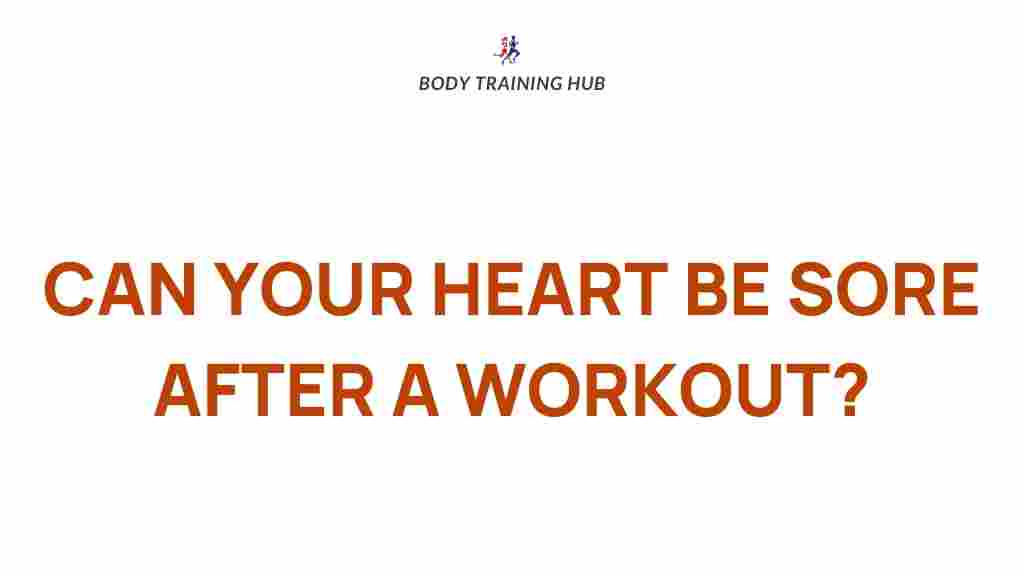The Science Behind Post-Exercise Heart Discomfort
After a rigorous workout, many individuals experience a range of sensations throughout their bodies, one of which is heart discomfort. While it’s common to feel some muscle soreness or fatigue, post-exercise heart discomfort can be alarming and is often misunderstood. This article delves into the science behind heart discomfort, the role of cardiovascular health in exercise recovery, and the myths surrounding post-workout soreness.
Understanding Heart Discomfort
Heart discomfort refers to any unusual sensation in the chest or surrounding area during or after physical activity. This discomfort can manifest in various forms, such as:
- Chest tightness
- Pain or pressure
- Shortness of breath
- Palpitations
It’s essential to differentiate between normal post-exercise sensations and those that may indicate a more serious issue. Understanding the underlying causes of heart discomfort can help individuals manage their fitness regimens safely.
The Role of Cardiovascular Health
Cardiovascular health plays a crucial role in how the body responds to exercise. A well-functioning cardiovascular system is essential for efficient blood flow and oxygen delivery to the muscles. Key factors influencing cardiovascular health include:
- Age: As we age, our cardiovascular system undergoes changes that can affect heart function.
- Fitness Level: Regular exercise strengthens the heart and improves circulation, reducing the risk of heart discomfort.
- Diet: A balanced diet rich in fruits, vegetables, whole grains, and healthy fats supports heart health.
- Hydration: Dehydration can strain the heart and exacerbate feelings of discomfort.
Maintaining good cardiovascular health is vital for reducing the risk of heart discomfort during exercise. Regular check-ups with a healthcare provider can help individuals monitor their heart health.
Post-Workout Soreness vs. Heart Discomfort
It’s important to distinguish between post-workout soreness and heart discomfort. Post-workout soreness, often referred to as delayed onset muscle soreness (DOMS), typically occurs in the muscles rather than the heart. The sensations of DOMS include:
- Muscle stiffness
- Swelling
- Reduced range of motion
While DOMS is a normal part of exercise recovery, heart discomfort can indicate potential issues that may require medical attention. Understanding these differences can help individuals better navigate their fitness journeys.
Common Causes of Post-Exercise Heart Discomfort
Several factors can contribute to heart discomfort following exercise, including:
- Overexertion: Pushing the body beyond its limits can lead to discomfort. Gradual increases in intensity are essential for safe exercise progression.
- Dehydration: Insufficient fluid intake can cause the heart to work harder, leading to discomfort.
- Improper Warm-Up: Failing to warm up adequately can increase the risk of muscle strain and heart discomfort.
- Underlying Health Conditions: Conditions such as hypertension or heart disease can predispose individuals to heart discomfort during and after exercise.
If heart discomfort persists or is accompanied by other symptoms such as dizziness, nausea, or sweating, it’s crucial to seek medical attention.
Exercise Recovery Strategies
Proper recovery strategies can mitigate post-exercise heart discomfort and enhance overall fitness outcomes. Here are some effective recovery practices:
1. Hydration
Maintaining hydration before, during, and after workouts is essential for cardiovascular function. Drink water or electrolyte-replenishing beverages to support recovery.
2. Nutrition
Consuming a balanced meal or snack post-workout can help replenish energy stores and promote recovery. Focus on:
- Protein for muscle repair
- Carbohydrates for energy restoration
- Healthy fats for overall health
3. Cool Down
A proper cool-down routine incorporating stretching and deep breathing can help regulate heart rate and prevent discomfort.
4. Rest
Allowing adequate time for rest and recovery is crucial. Overtraining can lead to increased heart discomfort and hinder progress.
Myths Surrounding Heart Discomfort and Exercise
Various myths exist regarding heart discomfort and exercise, contributing to confusion and anxiety among fitness enthusiasts. Here are some common misconceptions:
Myth 1: Heart Discomfort is Normal After Every Workout
While mild sensations may be common, significant heart discomfort is not normal and should be evaluated.
Myth 2: Only Older Adults Experience Heart Discomfort
Individuals of all ages can experience heart discomfort, particularly if they have underlying health issues or engage in intense exercise without proper conditioning.
Myth 3: You Should Ignore Heart Discomfort During Exercise
Ignoring discomfort can lead to serious health risks. It’s vital to listen to your body and seek help if needed.
Troubleshooting Heart Discomfort
If you experience heart discomfort during or after exercise, consider the following troubleshooting tips:
1. Assess Your Workout Intensity
Evaluate whether you are pushing your body too hard. Adjust intensity levels to suit your fitness level.
2. Monitor Your Heart Rate
Using a heart rate monitor can help you stay within safe exercise zones. If your heart rate exceeds recommended levels, reduce the intensity.
3. Check Your Hydration Status
Ensure you are adequately hydrated before, during, and after workouts. Dehydration can significantly impact heart function.
4. Review Your Warm-Up Routine
Incorporate dynamic stretching and light aerobic activity in your warm-up to prepare your heart and muscles for exercise.
5. Consult a Healthcare Professional
If heart discomfort persists, it’s essential to consult a healthcare professional for a thorough evaluation. They can provide personalized advice based on your health history.
Conclusion
Post-exercise heart discomfort can be a complex issue influenced by various factors, including cardiovascular health, workout intensity, and recovery practices. Understanding the science behind heart discomfort and differentiating it from post-workout soreness is crucial for safe exercise. By debunking fitness myths and implementing proper recovery strategies, individuals can enhance their exercise experience and minimize the risk of discomfort.
For further insights into fitness and health, consider exploring this resource on exercise recovery. Remember, knowledge is power when it comes to your health!
Maintaining an open dialogue with fitness professionals and healthcare providers can help ensure a safe and enjoyable fitness journey. Always listen to your body and prioritize your cardiovascular health as you strive toward your fitness goals.
This article is in the category Myths & Facts and created by BodyTraining Team
